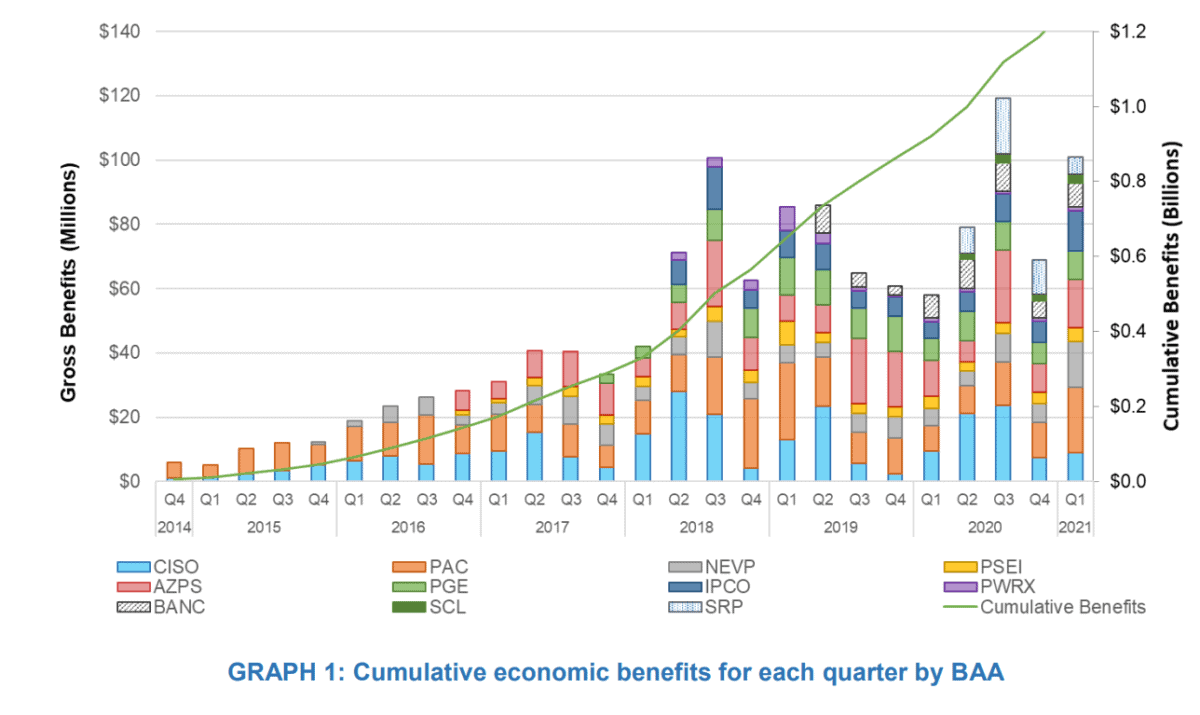
Tracy Rolstad
This is the last article in a three-part series about the Western EIM. You can read our first article, which provides an overview explanation of the EIM here, and you can find the seond aricle, which explores some of the practical consdierations of joinging the Western EIM here.
In this article, we look at EIM member cost savings and the benefits of participation, and PSC Technical Director Tracy Rolstad answers some common questions about the EIM.
In April, California ISO published the Western EIM Benefits Report for Q1 2021. The report defines benefits as “cost savings, increased integration of renewable energy, and improved operational efficiencies including the reduction of the need for real-time flexible reserves.”
At Q1 2021, CAISO reported $1.28 billion in gross benefits associated with participation in the EIM. As covered in Part 1 of this series, one of the primary drivers of cost savings via the EIM is the transfer of energy across balancing areas, which provides regions with access to lower cost supply. By leveraging more efficient dispatch in the Fifteen-Minute Market (FMM) and Real-Time Dispatch (RTD), EIM participants realized $101 million in gross benefits in Q1 2021.
Reduced Curtailment
In addition to accessing lower cost electricity, EIM allows utilities to significantly reduce curtailment of renewables by selling the excess supply to other participants whose needs might otherwise be met by conventional generation. According to CAISO, the total avoided renewable energy curtailment since 2014 is 1,400,055 MWh, resulting in 599,144 metric tons of reduced greenhouse gas emissions – a volume CAISO estimates to be equivalent to removing 125,967 passenger cars from the road for a year.
More Reliable Renewables
The increase of renewable generation presents new challenges for grid operators. Risks associated with the intermittency of resources like wind and solar are mitigated by sharing renewables across a larger footprint. By enabling the real-time dispatch of least-cost generation to participants, the EIM more efficiently clears imbalances between demand and production.
Common EIM questions
AL: So, I am a retail customer. Will my electric service providers membership in the EIM lower my retail rates?
TR: Well…not exactly. In the short term, it is unlikely you will see rate reductions in the retail rate due to your utilities’ membership in the EIM. However, in the longer term, you should expect to see EIM costs savings manifest themselves in the form of flat rates or lower rate increases. The EIM cost savings are real and represent the outcome of optimization of generation dispatch associated with the economies of scale within the EIM.
AL: Is the EIM just about intermittent (i.e., renewable and carbon free) generation and the need to balance the variable output of that generation?
TR No. The EIM is most definitely a trading ecosystem for short-term trading. We have heard, anecdotally, that the EIM has diminished the importance of the MID-C trading hub as the place to engage in short-term energy trading. The trades are still happening but perhaps in a different environment.
AL: What is the future of the EIM?
TR: All signs point to anyone with load & generation (of a notable amount) joining the EIM. The understanding the costs of joining the EIM are fairly well understood at this point so utilities should be comfortable with examining the economics related to joining the EIM. Another thing to note is that any new generation resource should be planned and designed such that its metering and telemetering fulfill the EIM demands of service. Another outcome of the EIM is greater clarity as to who is “in the market” and, presumably, greater liquidity in the energy market.
Eleven utilities are scheduled to join the EIM in 2021/2022, including BPA, Avista, and LADWP.
PSC provides clients with strategic consulting and engineering services related to entering the EIM. For more information about how PSC can support your organization with evaluation or entry to the EIM, contact us here or send us an email at [email protected].

